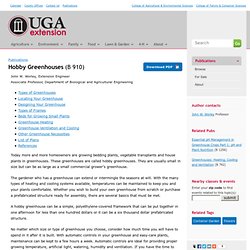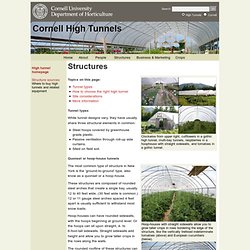

B910-Plan7.jpg 625×789 pixels. Hobby Greenhouses. Publications Download PDF John W.

Worley, Extension Engineer Associate Professor, Department of Biological and Agricultural Engineering Today more and more homeowners are growing bedding plants, vegetable transplants and house plants in greenhouses. These greenhouses are called hobby greenhouses. The gardener who has a greenhouse can extend or intermingle the seasons at will. A hobby greenhouse can be a simple, polyethylene-covered framework that can be put together in one afternoon for less than one hundred dollars or it can be a six thousand dollar prefabricated structure.
No matter which size or type of greenhouse you choose, consider how much time you will have to spend in it after it is built. Types of Greenhouses There are two basic types of greenhouses: attached and freestanding. Figure 1. Attached Lean-To A lean-to greenhouse is built against a building, using the existing structure for one or more of its sides. The lean-to has the following disadvantages: Attached Even-Span Figure 2. Use cattle panels to build an arched trellis & hoop house. I like to use the straw bale gardening method with a strong trellis for my tomatoes.

I like Kentucky Wonder green beans which require a taller trellis than I care to climb. I saw a make-shift arched trellis made from concrete re-mesh and immediately thought that could work for me! I could grow my two favorite vegetables on either side of an arch of wire that would be assessable to me from the ground. I also remembered how much fun the kids had under the "pickle teepee" we had made for them out of sticks, strings, and cucumber seeds years ago.
The kids could easily pick the cukes as they hung down on the inside of the little structure. The dimensions of the sections of re-mesh we used were very close to the dimensions of cattle panels, rigid fencing-type sections, sold at farm supply and feed stores. (Click to view a larger image that can be printed.) Materials for this 7' x 21' arched trellis green house: Optional materials: Equipment: General%20High%20Tunnel%20Planting%20Schedule. HH_Const_0809. FarmerTipsHoophouseUse. Hoophouse-howto. Low Cost High Tunnel Construction. Tim Coolong, University of Kentucky Introduction High tunnels are becoming increasingly popular for use by small farms who often market directly to consumers.

Although they have proven to be economically advantageous to farmers who wish to capitalize on high prices obtained either early or late in the growing season, permanent high tunnel structures do represent a significant capital investment. The cost for a standard size tunnel, including plastic (two layers) and all the materials required for construction can range from $1.50-$2.50 per square foot without labor and freight charges. This represents an initial investment of several thousand dollars, which is simply too much for some small farms.
Watch the High Tunnel Production and Low Cost Tunnel Construction Webinar » This low cost high tunnel only provides about 3 oF in frost protection, compared to 7 oF for a double poly tunnel. Constructing the high tunnel In this tunnel we have already laid plastic in the field and transplanted. High Tunnels. Structures Topics on this page: Tunnel types While tunnel designs vary, they have usually share three structural elements in common: Steel hoops covered by greenhouse grade plastic.Passive ventilation through roll-up side curtains.Sited on field soil.

Quonset or hoop-house tunnels The most common type of structure in New York is the ‘ground-to-ground’ type, also know as a quonset or a hoop-house. These structures are composed of rounded steel arches that create a single bay, usually 12 to 40 feet wide. (30 feet wide is common.) 12 or 11 gauge steel arches spaced 4 feet apart is usually sufficient to withstand most snow loads. Hoop-houses can have rounded sidewalls, with the hoops beginning at ground level. The rounded roofline of these structures can collect snow more than gothic type structures (see below). The length of the tunnels isn’t critical, since ventilation controlled by raising or lowering the sidewall. Gothic style tunnels Gothic style high tunnels have peaked roofs.
Anchoring.